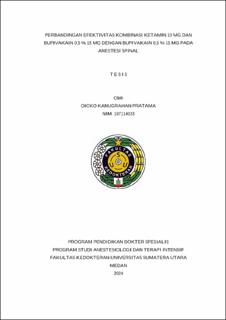| dc.description.abstract | Background:
Spinal anesthesia is regional analgesia by blocking nerve cells within the subarachnoid space by local anesthetic drugs. Bupivacaine is the most common agent, however, the duration of analgesia is often short. The duration can be extended by adding adjuvants such as ketamine. Ketamine as a single anesthetic agent produces psychomimetic disturbances and inadequate analgesia. However, as an adjuvant, it can accelerate the onset of action and reduce the dose of local anesthetic drugs required.
Objective:
To analyze the comparative effectiveness of the combination of ketamine 10 mg and bupivacaine 0.5% 15 mg with bupivacaine 0.5% 15 mg in spinal anesthesia.
Methods:
This study used a Randomized Clinical Trial design with double blind. The sample is divided into: group A (ketamine adjuvant) getting hyperbaric Bupivacaine 0.5% 15mg with Ketamine adjuvant 10mg and group B (Bupivacaine) getting Bupivacaine 0.5% 15mg. Data will be analyzed by unpaired T test or Mann-Whitney test.
Results:
There were 54 samples with a distribution of 27 samples in each group. There were significant differences in sensory and motor onset (p<0.001) as well as sensory, motor, and analgesia duration (p<0.001) between groups A and B. There were no differences in SBP (p=0.483), DBP (p=0.710), HR (p=0.505), RR (p=0.328), and SpO2 (p=0.290) at the initial examination (T0). At the 5th minute examination (T1), there were significant differences in SBP and HR (p<0.001), but not in DBP (p=0.169), RR (p=0.842), and SpO2 (p=0.142). At the 10th minute examination (T2), there were significant differences in SBP, DBP, and HR (p<0.001), but not in RR (p=0.898), and SpO2 (p=0.423). Adverse events were found to be more common in group B (n=28), with the most common adverse event being hypotension, while in group A (n=8) the most common adverse event was sedation.
Conclusion:
The combination of ketamine 10 mg and bupivacaine 0.5% 15mg is more effective than single bupivacaine 0.5% 15mg in spinal anesthesia of lower extremity surgery patients based on onset, duration, and hemodynamics. | en_US |


